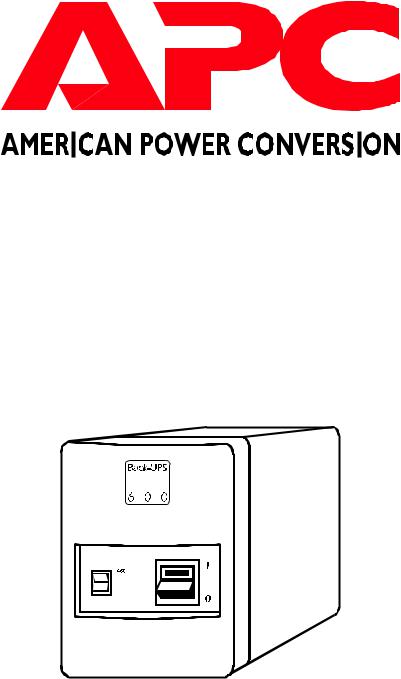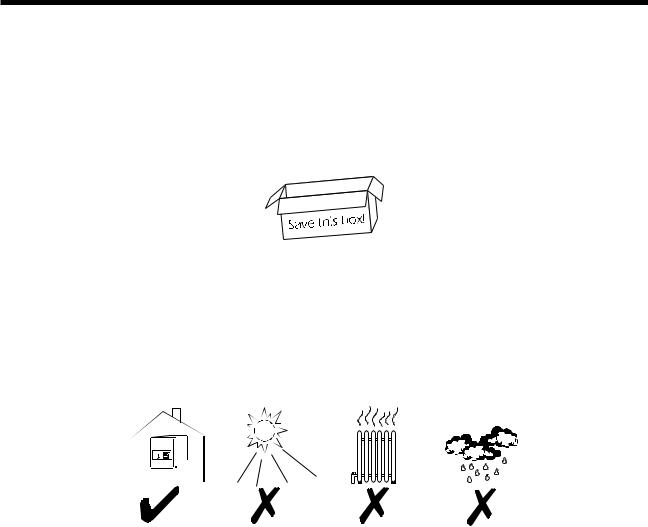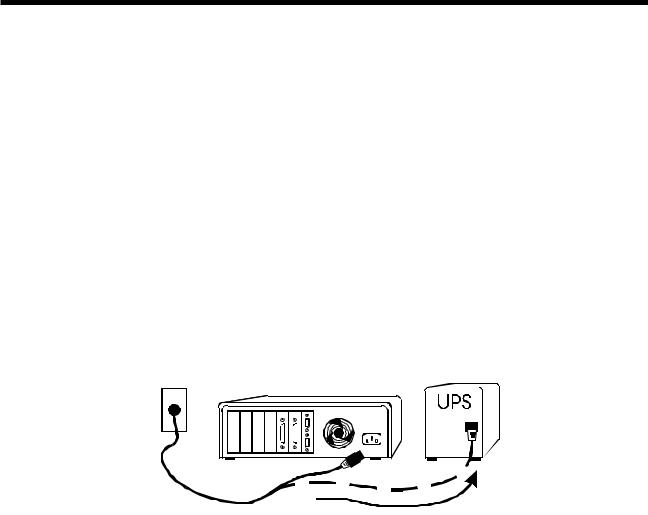American Power Conversion 250, 400, 600 User Manual

Back-UPS®
Models 250, 400 and 600
User's
Manual

Important safety instructions!
Please read this manual! Veuillez lire ce manuel!
Bitte lesen Sie dieses Anleitungshandbuch! ¡Se ruega leer este manual de instrucciones!
Thank you for selecting thisAmerican Power Conversion Uninterruptible Power Source (UPS). It has been designed for many years of reliable, maintenance free service. American Power Conversion is dedicated to the development of high performance electrical conversion and control products and we hope that you will find this UPS a valuable, convenient addition to your computing system.
This manual provides safety, installation and operating instructions that will help you derive the fullest performance and service life that the UPS has to offer. In addition, the manual describes the inner workings of the UPS and how they relate to providing superior protection from utility power problems such as blackouts, brownouts, sags, swells, EMI/RFI noise and surges.
Please save this manual!
It includes important instructions for the safe use of this UPS and for obtaining factory service should the proper operation of the UPS come into question. Down the road, service or storage issues may arise and require reference to this manual.
Please save or recycle the packaging materials!
The UPS's shipping materials were designed with great care to provide protection from transportation related damage. The shipping materials will become invaluable to you in case the UPS must be returned to the factory for service (damages sustained in transit when shipped from the user are not covered under warranty).
Entire contents copyright © 1993 American Power Conversion. All rights reserved; reproduction in whole or in part without permission is prohibited. Back-UPS and PowerChute are registered trademarks of APC. All other trademarks are the property of their respective owners.

Table of contents |
|
|
1.0 |
Introduction................................................................ |
2 |
2.0 |
Safety! ........................................................................ |
3 |
|
Sécurité! (Françias)....................................................................................... |
4 |
|
Sicherheit! (Deutsch) ................................................................................... |
5 |
|
Seguridad! (Español) ................................................................................... |
6 |
3.0 |
Installation ................................................................. |
7 |
4.0 |
Principles of operation .............................................. |
13 |
5.0 |
Controls and indicators ............................................. |
18 |
6.0 |
UPS monitoring......................................................... |
19 |
7.0 |
Difficulty ................................................................... |
21 |
|
Difficulté (Françias) ................................................................................... |
22 |
|
Schwierigkeit (Deutsch) ............................................................................ |
23 |
|
Dificultad (Español) .................................................................................. |
24 |
8.0 |
Storing the UPS......................................................... |
29 |
9.0 |
Run time versus load................................................. |
30 |
10.0 |
Specifications ............................................................ |
31 |
|
Warranty, Life support policy ................................ |
cover |
Page1

1.0Introduction
1.1Overview
The UPS is a high performance standby uninterruptible power source designed to protect computers and peripheral devices such as monitors, modems, tape drives, etc. from utility line failures which could result in the loss or corruption of valuable data. In the event of a utility failure such as a blackout, brownout, swell or sag, the UPS rapidly transfers loads (computer equipment) to an alternative power source. This alternative power is derived from a battery within the UPS and provides the user with ample time to save files and properly close operations. A chart in section 9.0 shows how much time your equipment can remain operating during a utility failure before the UPS’s batteries are drained. Under normal conditions when the utility voltage is within proper limits, the UPS maintains the battery in a charged condition and serves to isolate your equipment from surges and high frequency electrical noise.
After following the installation procedures and reading all the safety instructions, you’re ready to enjoy computing free from the worry of power problems and the time consuming process of constantly saving your files!
1.2 Surge suppression and EMI/RFI filtering
The UPS provides high performance surge suppression and EMI/RFI (electromagnetic and radio frequency interference) filtering. The UPS suppresses surges defined by the ANSI C62.41 (formerly IEEE 587) Category A and B standard to levels well below that which is compatible with your computer.
1.3 Remote interface
A remote computer interface port (400VA and 600VA models) capable of signalling utility failure and low battery conditions is provided for unattended shutdown of computer operations. When teamed with PowerChute UPS monitoring software, you may select operation of power event logging, power event notification, automatic restart upon power restoration, and battery conservation features.
Page2

2.0 Safety !
ENGLISH
■To reduce the risk of electric shock, disconnect the Uninterruptible Power Source from the mains before installing a computer interface signal cable (when used). Reconnect the power cord only after all signalling interconnections have been made.
■Connect the Uninterruptible Power Source to a two-pole, three-wire grounding mains receptacle. The receptacle must be connected to appropriate branch protection (fuse or circuit breaker). Connection to any other type of receptacle may result in a shock hazard and may violate local electrical codes.
■This Uninterruptible Power Source has an internal energy source (the battery) that cannot be de-energized by the user. The output may be energized when the unit is not connected to a mains supply.
■To properly de-energize the Uninterruptible Power Source in an emergency, move the I/O switch to the O (off) position and disconnect the power cord from the mains.
■AvoidinstallingtheUninterruptiblePowerSourceinlocationswherethereiswater or excessive humidity.
■Do not allow water or any foreign object to get inside the Uninterruptible Power Source. Do not put objects containing liquid on or near the unit.
■ToreducetheriskofoverheatingtheUninterruptiblePowerSource,avoidexposing the unit to the direct rays of the sun. Avoid installing the unit near heat emitting appliances such as a room heater or stove.
■The Protective Earth conductor of this UPS carries the Leakage Current from the load devices (computer equipment). This UPS generates approximately 0.75 mA of leakage current. To ensure a safe limit of 3.5 mA, the total leakage current of the load devices should be limited to 2.75 mA. If you are unsure of the leakage current from the load devices, ensure that this product is plugged into a 3-wire receptacle that has a reliable (low impedance) Protective Earth connection to provide a safe path for the leakagecurrent,andreplacethepowercordtotheUPSwithonethathasalockingtype plug (IEC 309) rated a minimum of 10A. This powercord may require the services of a professional electrician for the installation of the matching wall receptacle.
Page3

2.0 Sécurité ! |
|
FRANÇAIS |
|
|
|
|
|
■Pour réduire le risque d’électrocution, débranchez la prise principale de la source d’alimentationpermanente(UninterruptiblePowerSource),avantd’installerlecâble d’interface allant à l’ordinateur (si utilisé). Ne rebranchez le bloc d’alimentation qu’après avoir effectué toutes les connections.
■Branchez la source d’alimentation permanente (UPS) dans une prise de courant à 3 dérivations (deux pôles et la terre). Cette prise doit être munie d’une protection adéquate (fusible ou coupe-circuit). Le branchement dans tout autre genre de prise pourrait entraîner un risque d’électrocution et peut constituer une infraction à la réglementation locale concernant les installations électriques.
■Cette source d’alimentation permanente (UPS) est munie d’une source d’énergie interne (accumulateur) qui ne peut pas être désactivée par l’utilisateur. La prise de sortie peut donc être sous tension même lorsque l’appareil n’est pas branché.
■Encasd’urgence,pourdésactivercorrectementlasourced’alimentationpermanente (UPS), poussez l’interrupteur sur la position O (Off) et débranchez le cordon d’alimentation principal.
■Ne pas installer la source d’alimentation permanente (UPS) dans un endroit où il y a de l’eau ou une humidité excessive.
■Ne pas laisser de l’eau ou tout objet pénétrer dans la source d’alimentation permanente (UPS). Ne pas placer de récipients contenant un liquide sur cet appareil, ni à proximité de celui-ci.
■Pour éviter une surchauffe de la source d’alimentation permanente (UPS), conservez-la à l’abri du soleil. Ne pas installer à proximité d’appareils dégageant de la chaleur tels que radiateurs ou appareils de chauffage.
■Le conducteur de terre de protection de cette UPS (Alimentation ininterrompue en courant)acheminelecourantdefuiteprovenantdesdispositifsdecharge(équipement d’ordinateur). Cette UPS crée environ 0,75 mAde courant de fuite. Pour garantir une limite de sécurité de 3,5 mA, le courant total de fuite des dispositifs de charge doit être limité à 2,75 mA. Si vous n’êtes pas sûr du courant de fuite provenant des dispositifs de charge, assurez que ce produit soit enfiché dans une prise à 3 fils ayant une connexion de terre de protection fiable (à basse impédance) procurant un chemin sûr au courant de fuite, et remplacez le cordon secteur allant à l’UPS par un qui ait une fiche du type à verrouillage (IEC 309) et à valeur nominale de 10A. Ce cordon secteur peut exiger les services d’un électricien professionnel pour l’installation de la prise murale correspondante.
Page4

2.0 Sicherheit !
DEUTSCH
■Um die Gefahr eines elektrischen Schlages auf ein Minimum zu reduzieren, die unterbrechungsfreie Stromversorgung vom Stromnetz trennen, bevor ggf. ein Com- puter-Schnittstellensignalkabel angeschlossen wird. Das Netzkabel erst nach Herstellung aller Signalverbindungen wieder einstecken.
■DieunterbrechungsfreieStromversorgunganeinegeerdetezweipoligeDreiphasenNetzsteckdoseanschließen.DieSteckdosemußmiteinemgeeignetenAbzweigschutz (Sicherung oder Leistungsschalter) verbunden sein. Der Anschluß der unterbrechungsfreien Stromversorgung an einen anderen Steckdosentyp kann zu Stromschlägen führen und gegen die örtlichen Vorschriften verstoßen.
■Diese unterbrechungsfreie Stromversorgung besitzt eine interne Energiequelle (Batterie), die vom Benutzer nicht abgeschaltet werden kann. Der Ausgang kann eingeschaltet werden, wenn das Gerät nicht an das Stromnetz angeschlossen ist.
■Um die unterbrechungsfreie Stromversorgung im Notfall ordnungsgemäß abzuschalten,denI/O-SchalteranderRückseiteaufO(Aus)stellenunddasNetzkabel aus der Steckdose ziehen.
■DieunterbrechungsfreieStromversorgungnichtaneinemOrtaufstellen,andemsiemit Wasser oder übermäßig hoher Luftfeuchtigkeit in Berührung kommen könnte.
■Darauf achten, daß weder Wasser noch Fremdkörper in das Innere der unterbrechungsfreien Stromversorgung eindringen. Keine Objekte, die Flüssigkeit enthalten, auf oder neben die unterbrechungsfreie Stromversorgung stellen.
■Um ein Überhitzen der unterbrechungsfreien Stromversorgung zu verhindern, das Gerät vor direkter Sonneneinstrahlung fernhalten und nicht in der Nähe von wärmeabstrahlenden Haushaltsgeräten (z.B. Heizgerät oder Herd) aufstellen.
■Der Erdableitstrom des Verbrauchers (Computer) fließt über den Schutzleiter des UPS-Netzgerätes ab Das UPS-Netzgerät selbst erzeugt einen Erdableitstrom von ca 0,75 mA. Um den Sicherheitsgrenzwert von 3,5 mAnicht zu überschreiten, sollte der Erdableitstrom sämtlicher Verbraucher auf 2,75 mA begrenzt sein. Wenn Ihnen die Höhe des Ableitstromes von den Verbrauchern nicht bekannt ist, dann sorgen Sie dafür, daß dieses Gerät an eine Steckdose mit Schutzkontakt angesschlossen wird, der eine zuverlässge (geringe Impedanz) Schutzleiterverbindung hat, um einen sicherenStrompfadfürdenErdableitstromzugewährleisten. ErsetzenSiezudemdie Netzanschlußleitung des UPS-Netzgerätes durch eine Netzanschlußleitung mit einerverriegelbaren,industriellenSteckvorrichtung(nachIEC309),diefürmindestens 10Ampere ausgelegt ist. Eine derartige Netzanschlußleitung erfordert eventuell die InstallationeinerentsprechendenNetzsteckdoseinderWanddurcheinenElektriker.
Page5

2.0 ¡ Seguridad ! |
|
ESPAÑOL |
|
|
|
|
|
■Parareducirelriesgodedescargaeléctrica,desconectedelaredlaFuentedeenergía ininterrumpibleantesdeinstalarelcabledeseñalizacióndeinterfazdelacomputadora (si se usa). Vuelva a conectar el conductor flexible de alimentación solamente una vez efectuadas todas las interconexiones de señalización.
■Conecte la Fuente de energía ininterrumpible a un tomacorriente bipolar y trifilar con neutro de puesta a tierra. El tomacorriente debe estar conectado a la protección de derivación apropiada (ya sea un fusible o un disyuntor). La conexión a cualquier otro tipo de tomacorriente puede constituir peligro de descarga eléctrica y violar los códigos eléctricos locales.
■Esta Fuente de energía ininterrumpible tiene una fuente de energía interna (la batería) que no puede ser desactivada por el usuario. La salida puede tener corriente aun cuando la unidad no se encuentre conectada al suministro de red.
■Para desactivar correctamente la Fuente de energía ininterrumpible en una situacióndeemergencia,coloqueelinterruptorI/OenlaposiciónO(Off-desconectado) y desconecte de la red el conductor flexible de alimentación.
■No instale la Fuente de energía ininterrumpible en lugares donde haya agua o humedad excesiva.
■No deje que en la Fuente de energía ininterrumpible entre agua ni ningún objeto extraño. No ponga objetos con líquidos encima de la unidad ni cerca de ella.
■Para reducir el riesgo de sobrecalentamiento, no exponga la unidad a los rayos directos del sol ni la instale cerca de artefactos que emiten calor, como estufas o cocinas.
■El conductor de protección a tierra conduce las corrientes de fuga de esta fuente ininterrumpible de potencia (UPS) generadas en los componentes de carga (equipos de computadora). La fuente ininterrumpible de potencia genera aproximadamente 0,75 mA de corriente de fuga. Para garantizar un límite de seguridad de 3,5 mA, el total de la corriente de fuga de los componentes de carga deberá limitarse a 2,75 mA. Si usted no está seguro del total de las corrientes de fuga de los componentes, asegúrese de que este producto esté conectado a un receptáculo de tres conductores que tenga una conexión de protección a tierra que sea confiable (impedancia baja) para proveer un camino seguro para la corriente de fuga. También asegúrese de reemplazar el cable que va a la fuente ininterrumpible de potencia con uno que tenga unenchufecondispositivodecierre(IEC309)concapacidadparaunmínimode10A. Estecablepudierarequerirlosserviciosdeuneletricistaprofesionalparalainstalación del receptáculo en la pared.
Page6

3.0Installation
3.1Receiving inspection
Once the UPS has been removed from its shipping container, it should be inspected for damage that may have occurred while in transit. Immediately notify the carrier and place of purchase if any damage is found. Two output jumper cords are provided with the UPS. The packing materials are made from recyclable materials and should be saved for reuse or disposed of properly.
3.2 Placement
The UPS may be installed in any protected environment. The location should provide adequate air flow around the unit, in an atmosphere free from excessive dust, corrosive fumes or conductive contaminants. Do not operate the UPS in an environment where the ambient temperature or humidity is outside the limits given in the Specifications section of this manual.
3.3 Load types
The UPS is designed to power all modern computer loads and associated peripheral devices such as monitors, modems, cartridge tape drives, external floppy drives, etc. The UPS is not rated to power life support equipment (as described on the rear cover of this manual).
Caution: The output waveform of this UPS is a sine wave approximation suitable for use with modern computer power supplies. Other load types may malfunction. In particular, ferroresonant type regulating transformers are not recommended. Use of a surge suppressor connected to the output of this UPS may unnecessarily load the UPS when on-battery. This UPS contains high performance surge suppression - additional suppression components are not required and are not recommended. If in doubt, please consult the equipment manufacturer or the factory.
Page7

3.0 Installation
3.4 Connecting to the utility
The UPS is furnished with two 1.8 meter output power cords for connection to computer equipment having “IEC 320” male appliance couplers at their input. However, due to the variety of plug connectors required for connection to electrical service in countries where the UPS may be operated, an input line cord is not supplied from the factory. In most cases this will not be a problem as the input cord which currently powers your computer equipment may be swapped with one of the supplied output cords. Hence, the swapped out line cord can be used instead as the input line cord for the UPS. If this is not the case, ask your local dealer or the factory about obtaining an input line cord for your application. Extra output power cords are also available from the factory.
The UPS is compatible with all 220, 230 and 240 Vac mains voltages. During a mains failure, the UPS powers your load at a nominal voltage of 225 Vac.
3.5 Battery charging
The UPS is shipped from the factory with its internal battery in a fully charged state. However, the battery may lose some charge during shipping and storage. The battery should be recharged before conducting the followingTest for proper operation (section3.7) and to ensure that the UPS will provide expected run time. The UPS may be used immediately upon receipt, but may not provide expected run time in the event of a utility failure. The battery will recharge to full capacity within 6 hours when the UPS is plugged in and switched on. Once the battery has obtained a full charge, the UPS will maintain the charge as long as the UPS is plugged in, regardless of the position of the power I/0 switch.
Page8

3.0 Installation
3.6 Connecting your equipment to the UPS
To ensure that your computer equipment will be protected during a utility failure and that you receive expected run time, it is important that you determine the total power needs of the equipment you wish to protect with the UPS. The power requirements of your equipment should be less than or equal to the capacity of the UPS. The capacity rating of the UPS, in both Volt-Amperes (VA) and Watts (W), is given in the Specifications section of this manual.
The power demands of your equipment can be read from the Run Time Verses Load (section9.0) chart or may be deduced from the equipment name plates. The Run Time Versus Load chart gives equipment power requirements (load) in VA for computer systems common in the office environment today. If your equipment is not listed in the chart, the following instructions will help you to determine their power needs.
3.6.1Computer equipment manufacturers must provide a load rating for their products. Usually, the rating is written on a name plate or label near the line cord. The rating may be given in units of Amps (A or Amax), Volt-Amperes (VA) or Watts (W). Jot down the load rating of all the equipment you wish to protect.
3.6.2All noted load ratings should be converted to Volt-Amperes (VA) so that all equipment power requirements can be added using the same units of measure.
3.6.3If load ratings are given in Watts (W), convert to an estimate of power requirements in VA by multiplying the value in Watts by 1.4.
3.6.4If load ratings are given in Amps (A or Amax), convert to an estimate of power requirements in VA by multiplying the value in Amps by 230. Unfortunately, many computer manufacturers overrate the power requirements of their equipment in order to be conservative and to cover the extra power demand of user added expansion boards. If the VA requirement that you have computed seems high or is already greater than the capacity of the UPS, don’t worry. The next section describes a test that you can perform to determine whether or not your equipment and the UPS are compatible, even if the computed power requirement of your equipment is 50% greater than the capacity of the UPS!
Page9
